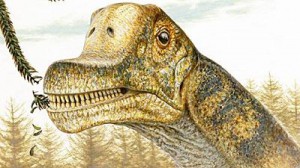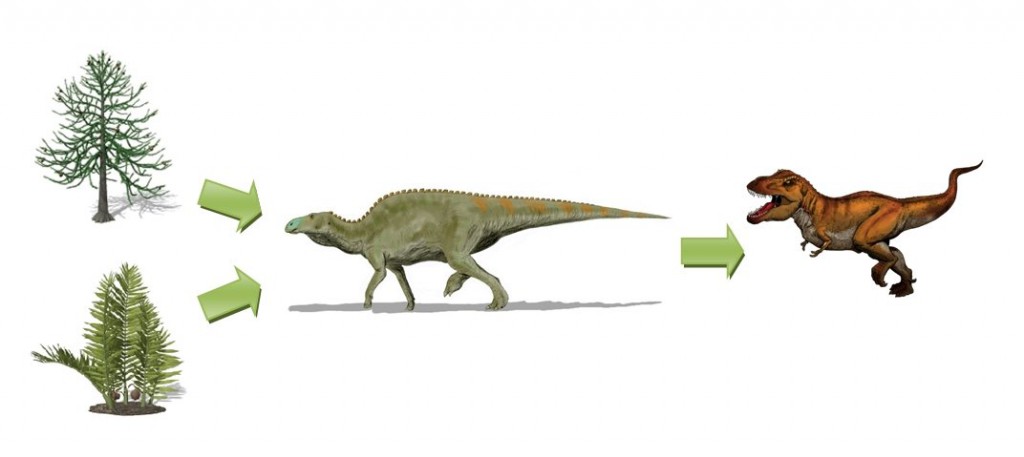
Abydosaurus having breakfast. (This was found on the internet without a credit; if this is your image, please let us know)
For the last week I have been busy researching the details of the food chain of the first inhabitants on Dinosaur Island: Tyrannosaurus rex, Edmontosaurus regalis, Nipa and Araucaria. The papers that I have been reading are: “Could Tyrannosaurus rex have been a scavenger rather than a predator? An energetics approach,” Ruxton and Houston, The Royal Society, February 2003; “Giants on the landscape: modeling the abundance of megaherbivorous dinosaurs of the Morrison Foundation (Late Jurassic, western USA),” Farlow, Caroian and Foster, Historical Biology, Vol. 22, No. 4, December 2013, pp. 403-429 and “Sauropod Feeding and Digestive Physiology“, Hummel and Clauss, Biology of the Sauropod Dinosaurs”, Indiana University Press, 2011 pp. 11-33.
The first food chain on Dinosaur Island is illustrated below:

The T. rex, Edmontosaurus regalis, Nipa and Araucaria food chain. How much energy does the Edmontosaurus receive from eating one Nipa plant? How much energy does the T. rex receive from eating one Edmontosaurus?
What we are trying to ascertain is exactly how much energy is transferred each step of the way. How much energy does the Edmontosaurus receive from eating one Nipa plant? How much energy does the T. rex receive from eating one Edmontosaurus?
For example, in Sauropod Feeding and Digestive Physiology we learn that Araucariaceae is estimated by one source to produce 7.0 Mega Joules per kilogram of dry matter but by another source as between 6.3 and 10.8 Mega Joule per kilogram of dry matter. In Giants on the landscape: modeling the abundance of megaherbivorous dinosaurs of the Morrison Foundation one model is that the estimated energy consumption for a megaherbivore is 55 kilo Joules over kilograms of body mass0.75 per day and another model is for 550 kilo Joules over kilograms of body mass0.75 per day. In Was Tyrannosaurus rex a scavenger? there are also estimates for the energy produced per kilogram of carrion and the amount of energy needed by T. rex if it was a scavenger (slow moving) or a hunter (very fast moving).
As I’ve said before: I’m a computer scientist, not a paleontologist and right now I feel like I’m back in grad school just trying to keep up with my first year classes. However, I have no doubt that Dinosaur Island will be a very useful tool for answering some of the questions raised in these papers.
